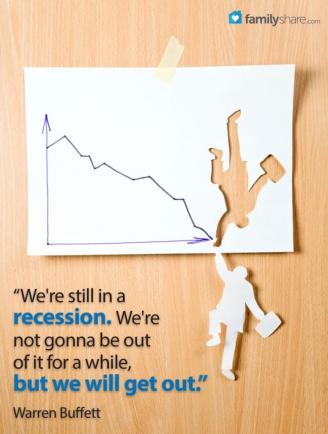
Investing during a recession can be scary. Especially in the early stages of a recession, asset prices for stocks, bonds and real estate may all fall. (In some recessions, real estate doesn't fall because lower interest rates make buying a home easier, offsetting the recessionary pressure.)
Here is a simple guide to investing in a recession
Keep investing
Even though asset prices may be falling, keep investing at the same rate you were before the recession. There are several patterns doomed to fail - invest when the market is rising and then sell when the market falls, resulting in losses or buy when prices fall and sell when they fall even further in a panic, resulting in losses. Stocks and real estate rise consistently only in the long term. The winning strategy is to buy and hold, avoiding the risk of selling at a loss and the cost of frequent trading.
Diversify
Review your investment portfolio in a recession to be sure that it is reasonably diversified. If you have too much of your money invested in a single stock, you should look to sell a portion of your position and buy investments in other companies. Ideally, you would have twelve or more different stocks in your portfolio.
Allocate assets
The concept of asset allocation is that you should have some of your assets invested in stocks, some in bonds, some in cash and perhaps a portion in real estate. The percentage you allocate to each class or kind of assets is a function of your appetite for risk. Stocks and real estate tend to be riskier than bonds and the only risk in cash is that it doesn't earn much. Don't make changes in asset allocation based on economic cycles; if you allocate more to stocks in good economies and less in recessions, you'll be finding yourself buying stocks at high prices and selling them at low prices. Weather the storms. It is easier to weather the storms if you have assets in multiple classes so they don't all go up and down together.
Buy mutual funds
You can get great diversification and asset allocation by buying mutual funds or ETFs (exchange traded funds). Each fund invests in many different investments. Even if you have a million dollars, you can get good diversification and asset allocation by choosing a variety of funds. No more than ten funds would be required to get the benefit you're looking for. If your portfolio is smaller, you can have good allocation and diversification with just three or four funds. This makes investing easy on you and keeps your portfolio growing.
Buy the losers
To manage asset allocation, just use the new money you invest to add to your funds that are under-performing. That's right, put your new money to work in the funds that are doing the worst. Your exposure to that asset class has been reduced by the under-performance. For example, let's say you own three mutual funds, a large cap balanced fund (a fund that invests in stocks of large companies without a bias for growth stocks or value stocks), a medium term bond fund and a fund that invests in real estate. If the large cap balanced fund performs worst, your allocation of assets will have shifted with less of your money invested in that asset class. Put your new money there to get that asset class back up to your target level.
By following these simple tips you can preserve a bit more value during the recession and recover when it ends. The stock market is a leading economic indicator, meaning that stocks will rise before the recession ends simply because investors believe that it will end. For this and other reasons, it is challenging to time the market. Having a long-term investment strategy and sticking with it through thick or thin will generally serve you well.
This article was originally published on FamilyShare.com. Check out these other related articles: Mickey, Microsoft or Mo's Snow Shack: Here are 5 things to know before you invest, 3 keys to successful investing and Investing 101 for the true novice.

